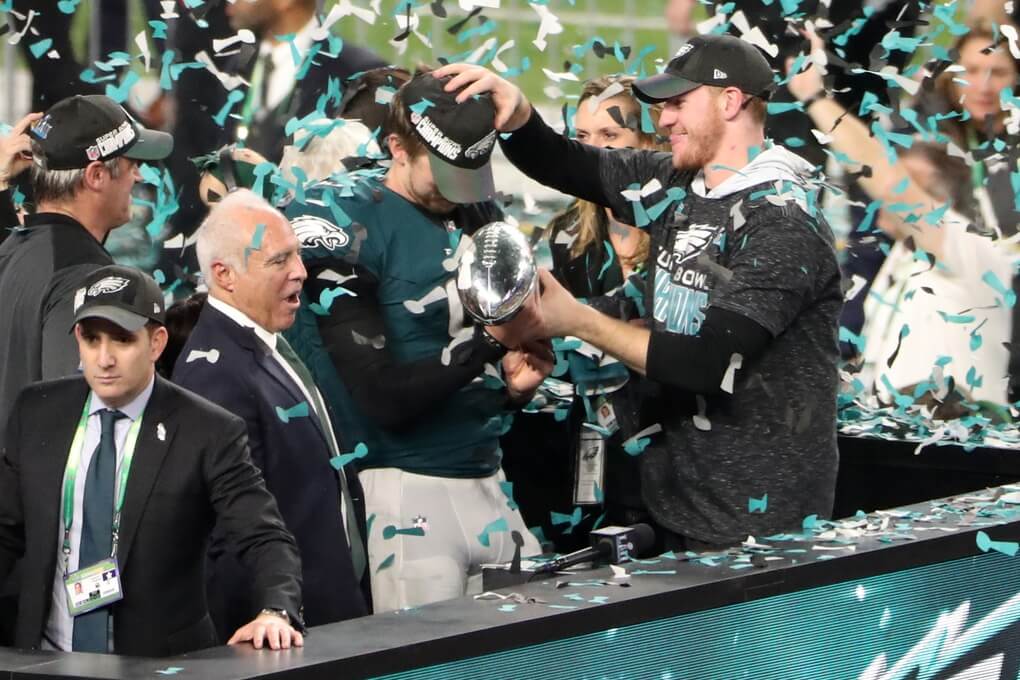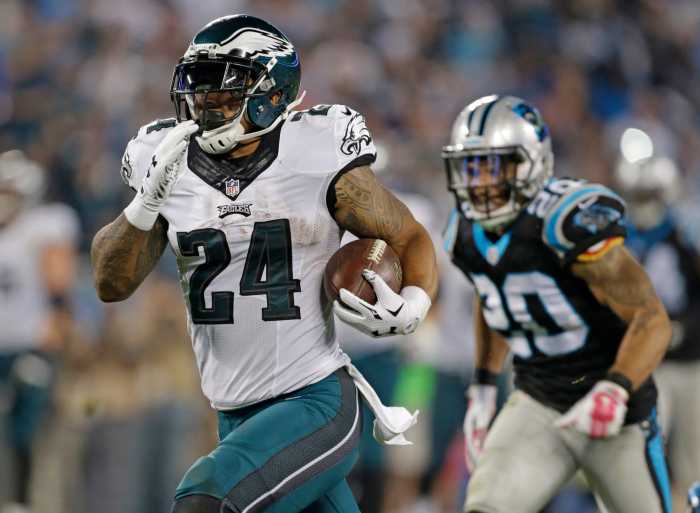This is the final installment of The Great Eagles Quarterback Debate; one that intends to diagnose the difference in film between the two signal callers. Since the Eagles’ season has come to an unfortunate end, let’s also take a look at how Carson can mimic Nick Foles’ play style to revamp the offense in 2019. It’s a lot to digest, so allow yourself some time. Conclusively, down season aside, I hope to put you at ease with Captain Carson moving forward. While I, among most other analysts, believe Wentz to be the superior quarterback, there are certain things that Nick does objectively better. In an offense submersed in talent, Wentz often drowns in individual pressure trying to make plays work. Foles, on the other hand, has always brought about an ease to quarterbacking unmatched by many. Besides experience, what can Carson learn from Foles and bring to the table in 2019-2020 to take his game to the next level? Moreover, what can be drawn from the film to explain Wentz’ decline from year two to year three.
Nick Foles: The Film
As you can see from the last two articles, there are many obvious differences between the two QBs. The numbers show only half of the story and overlook some key differences in the play style of both pivots. In this article, there are two questions to answer. The first is why has offense the looked better this year under Nick Foles? The second is what has been the difference between Wentz in 2017 and 2018?
To respond to the first of our inquiries: the biggest, and most significant is timing. Using examples from the Houston and LA game, let’s look at the offense’s timing under Foles. Then we will look at a few plays from the playoff game against the Saints to see what happens without said timing. Other focuses of this film diagnosis include: Foles’ willingness to take a hit, and his quick release — both of which keep the offense on time. I recommend you watch all the following clips on a reduced speed to really grasp the crux of the point being made. I’ll admit, finding evidentiary film using highlight videos is not ideal, however, as this is what I have access to, I will do my best. First, let’s examine chronological examples from the highlights the record-setting Texans game:
WEEK 16 VS TEXANS
0:36 – Quick swing to Darren Sproles. Foles’ quick release is really on display here. He looks up-field just enough to keep the defense honest and fires a rope to hit Sproles in stride. If the pass was a split second later, it would have been deflected or intercepted by the oncoming defender. This is not to say that Wentz isn’t capable of making this throw, however, it has proven a harder pass for Wentz to make due to his long release. Foles has a much straighter release that begins from his shoulder, almost side-arm. You’ll see from the film below that Carson has a more pronounced motion on his release.
3:07 – Wheel route to Sproles. Both of these examples are perfect illustrations of what a healthy Sproles brings to the offense — something that was touched on earlier in the series. With pressure in his face, Foles side arms the football a-la Phillip Rivers. Another example of what he is able to accomplish with his short windup, Nick delivers a beautiful arching ball to the running back in stride down the sideline. This is actually one of the few times Foles holds on to the ball once he reaches the last step of his drop; likely by design.
With space to the outside, a healthy Carson Wentz may have seen a running lane and taken it. This is not a negative aspect of Carson’s game, but it disrupts the timing of the offense and allows defenses to sit back and react. There are examples below in which Carson takes an unnecessary sack or misses an open window because he is too focuses on making a play with his feet. Quick aside, in the last article, I mentioned how significant getting Sproles involved in the offense early can be for the rest of the receivers. The game plan to target him early and often is evident with these two plays.
3:19 – Play action dig over the middle to Ertz. This is not an example of a play that Nick Foles executes better than Wentz, rather an example of a play that we have seen Wentz miss high this season, and in the past. Notice how much torque is generated from Foles lower back, due to the fact he is unable to get his feet perfectly set. This is a throw that, without said rotation, relies solely on arm strength and is much more likely to float, or not have the requisite arc to beat the linebacker sitting underneath the route.
This is significant for two reasons. The first: it has been suggested that Wentz, who ended the season on the bench due to a back injury, was hurt much earlier in the season than indicated by the injury report. Secondly, a longer release allows more time for the trajectory of the throw to be altered. That means that throughout the throwing motion, a misstep or a bad angle will modify the height of the throw that much more. Keep this in mind when we review Carson’ film.
6:56 – This is a play to debunk those who believe Wentz is more prone to silly mistakes than Foles. The numbers don’t support this theory and neither does the film. This is essentially the exact same interception that Wentz threw in Dallas and against the Colts earlier in the year. Nick tries to force the ball into Ertz, another criticism of Carson, and the linebacker is rewarded for his draping coverage with an interception. In fact, Foles’ interception in the Rams game is cut from the same cloth. The overuse of Ertz is an issue that plagued OC Mike Groh’s scheme this year, especially early in the season, despite it being generally noted as one of Carson’s individual failures. It also demonstrates how instrumental timing is to Nick’s success. Forced to hold onto the football, he clearly feels uncomfortable and chances an ill-advised throw.
8:15 – Big touchdown throw to Nelson Agholor. A play in which the difference between Wentz and Foles needs a bit of explanation. The replay at 8:35 gives an even better look at what Foles sees. At 8:38, you and I see what I believe Carson sees — a wide-open running lane for a first down. Instead, Nick has his eyes all the way downfield, knowing that he is rarely able to generate ample yards with his legs. Feeling fully comfortable in the pocket is a learned attribute for NFL quarterbacks and its something that Carson had by default in 2017 due to superb pass blocking. This year, with more sacks, came less patience keeping his eyes downfield. Moreover, it is my belief that due to injury, Carson was much less comfortable taking a potential shot to stay in the pocket and has been more likely to take his eyes off his receiver to protect himself.
14:46 – Most important play of the game — a deep dig from Alshon Jeffery and a roughing the passer penalty to set up the game-winning field goal. Foles takes a colossal hit from Jadeveon Clowney, one that takes him out of the game for a time, to deliver a very contested throw to Alshon Jeffery. This chemistry between Foles and Alshon is not something we have seen to the same extent between the star receiver and the younger quarterback. Wentz has been less likely to toss up contested throws to Alshon over the middle. Again, this could be another indication of the issues he was having with his back. However, it is most likely due to the fact that Foles and Alshon worked together all offseason while Wentz was rehabbing his knee. Nick’s willingness to take a big shot from Clowney is a testament to his underappreciated toughness. This is not a hit many would want to take with a painful back injury, although we have seen Carson make this throw before.
WEEK 15 AT RAMS
Moving on to the surprising defeat of the LA Rams. This is a brief aside, and I chose to put it second, as Foles didn’t have to be magical in this one. The run game carried the upset and Foles did his part to fuel it.
0:14 – A clip for the doubters who say Nick Foles is not mobile. In this scenario, I fancy Carson to run the football in this situation. He’s got a good lane, and a solid lead blocker in front of him in Dallas Goedert. When Carson does decide to throw on the run, his preference has been to push the ball further downfield. Again, not a knock on Carson nor Nick, just an example of the difference both players bring to the offense.
5:53 – A deep bomb to Alshon and Nelson. With a defender in his face, Foles takes a hit to deliver a long arching throw to a wide open Alshon Jeffery. Knowing that he has the athleticism to best most defensive lineman, this is a scenario in which Carson would likely make a move to buy more time for himself, thus possibly missing the window to complete a deep shot downfield. Foles also has better anticipatory skills at this point in his career than Carson, but that will come to the young playmaker with time and practice. Steadying his footwork will also go a long way to improve his accuracy on anticipatory throws. Even having to move around to avoid pressure, Foles rarely takes more strides than necessary maneuvering around the pocket.
6:45 – A simple, but a great example of how Nick Foles keeps this offense on time. If you’re an avid watcher, you’ll know plays like this are a prime example of the Foles offense in a nutshell. Without even waiting for other receivers to finish their routes, Nick takes what he is given and tosses the ball to his best run-after-the-catch receiver in hopes he can make a play. Right after Golden Tate makes the reception, you’ll see a wide-open Ertz streaking down the field at the top of your screen. This is the biggest difference between the young Wentz and the veteran Foles. Experience has taught Nick to take what he is given, and not to second guess it. An often cited complaint of Wentz’ play this season is he failed to do just that.
DIVISIONAL ROUND AT SAINTS
Now we move to the Saints game. In the first quarter, we saw just how lethal Foles can be when the offense is kept on time. Saint Nick got rid of the ball quickly and efficiently and the offensive line did more than their part to keep him unscathed. We also got to see the flip side, when Foles is forced to hold onto the ball and his timing is disrupted.
Let’s briefly diagnose the highlights from the first touchdown drive, beginning at 0:19. It’s 3rd and 1 and Doug Pederson dials up a familiar run-pass-option. Again, Nick Foles’ quick release is on display, but this is something we’ve seen time and time again from Wentz, Ertz, and Pederson. Nevertheless, last season we saw just how much RPO action they tossed in the playbook when Foles took over. It is a staple of the offense, and it really allows Nick to shine.
The beautiful touchdown throw to Jordan Matthews comes at 0:49. Here again, we see a major difference between Wentz and Foles — anticipation. What I’ve noticed from Carson is that he likes to see his receiver get open downfield before releasing a deep shot. Moreover, with a defender coming off the edge in a hurry, he makes a lot of his spectacular plays after making an oncoming rusher miss before offloading a pass or scrambling. Had Foles done the same, the window to hit Matthews in stride would have been missed.
1:48 – Nick Foles has an understanding that once he reaches the back end of his drop, he must release the ball. In these situations, he has a particular favorite. We see many examples later in the game where he throws the ball up to Alshon, despite him being well covered, in hopes that he will make a catch as he did on this play (5:41; 7:01).
3:11 – Here we see exactly what happens when Foles’ timing is even the slightest bit affected. He does not have the escapability or improvisational skills that Carson does. Nor does he have the arm strength to loft this pass over the top of the defender, who instead intercepts the ball. He has Ertz wide open if he could just put a little more oomph behind the pigskin. Forget what the Saints said about their brilliant fake punt, this play was the turning point of the game.
For the next two-and-a-half quarters, Eagles fans stand witness to what happens when a defense is able to throw off the timing of the Nick Foles offense. The Saints’ corners move closer to the line of scrimmage to force Foles to hold the ball and disrupt free lanes down the field for Eagles’ receivers.
9:28 – Foles’ timing is disrupted, and again, he does not have the arm strength to get the ball to Golden Tate, who actually beats his man. This is a throw we’ve seen Carson make before. This is also a throw we’ve seen Carson miss over the top before.
All in all, we see a few themes arise from a small glimpse into the film on Nick Foles. Number one: clean footwork, a quick release and a dedication to keep the offense on time. On the flip side, we can also see his inefficiencies when knocked off his timing. This is really at the core of the transition from Wentz to Foles. Number two: a willingness to take a hit to deliver a pass. This isn’t necessarily a trait that Carson doesn’t possess, however, we saw much more of it in 2017 than last season — especially late in the season. We’ll look into how his injury could have played a potential role in this. Foles brought it back to the offense and was rewarded dearly for it. Number three: anticipation. Nick is just better at leading receivers and reading defenses. The hope is that Wentz continues to learn how to read NFL defenses and predict open throws. Keep in mind he came from a division two offense and was much better in year two than year one.
Carson Wentz: The Film
To fully grasp the struggles of Carson Wentz in 2018, a full game-by-game analysis would be required. What I have done instead it attempted to take small portions of a few games throughout the season to highlight the ups and downs of this tumultuous season. He is suspected to have injured his back in Week 6 in the game against the New York Giants. It’s hard to fully equate the effect this had on the rest of the season. He didn’t seem to be incredibly held back in Week 7 against the Panthers, but as the season went on, a lack of mobility in his rotation starts to show. Following a lengthy recovery process after an awful ACL injury, we also didn’t see Wentz run as often, or as effectively.
WEEK 3 VS COLTS
We’ll begin the analysis with Carson’s first game back facing Frank Reich’s Colts in Philadelphia. It was a good outing from Wentz despite showing some obvious rust throughout the game. The Eagles are coming off a surprising loss to the Tampa Bay Buccaneers and are still figuring out their offense. It was a close game against a playoff team that turned out to be much better than most people gave them credit for early on in the season.
0:12-0:55 – Wentz’ first drive returning from his ACL injury. He is on time, on target and looks light on his feet. On 2nd and 10, he forces the first throw down the field to Ertz in a tight despite having options open underneath — but boy is it a beauty. This is the give and take with Carson. He is an aggressive passer, and when he can be aggressive in a timely fashion, and throw tight window passes like this one, he is hard to beat.
1:11 – The most convincing argument for Wentz over Foles is his athleticism. It is certainly on display here. However, you’ll notice as Carson hits the end of his drop, he doesn’t have the anticipation Nick has to read the leverage of his receivers. While each option is less than perfect, there are available windows to throw to. Instead, he notices the pressure coming and lowers the ball and his eyes to attempt to make an incredible out of what could have been an easy completion. A pro in some situations and a con in others, Carson should get better at deciphering when he should make a play and when he should stay.
1:28 – Carson takes an unnecessary sack. Generally, facing 3rd and 13, teams will look to pass beyond the sticks to ensure the first down. What we have seen from Nick Foles is that he is willing to throw the ball underneath and allow his playmakers to, well, make plays. At precisely 1:32, Corey Clement turns to receive what could be an easy pitch-and-catch. Wentz, in the same frame, has his head down and is already thinking run. While we can all appreciate Carson’s gumption, in this situation he needs to take what the defense gives him. How many times have we seen Corey out-muscle or out-hustle defenders for a much-needed first down? If nothing else it makes for a closer field goal try for Jake Elliot.
3:53 – An incredible play by Wentz. A diving first down that set the league on notice that Carson Wentz was back. Only a handful of quarterbacks in the last 20 years can make plays like this. High effort moves like this start to come fewer and further in between as the season going on.
7:12 – This is the type of improvisation we need to see more of in 2019: movement while keeping his eyes and torso facing upfield. Goedert is going to feast off of opportunities like this in his second year.
7:33 – Super slow-mo time. This is an example of how Wentz long-winded wind-up causes him trouble. Without being able to step into his throw, the arching motion of his release — due to him coming upwards from his shoulder, as opposed to forwards through his shoulder like Foles — causes the ball to fall short. Wentz hasn’t yet developed the quick-release, side-arm marksmanship that Nick Foles has. Full marks to Margus Hunt for making his presence felt on the pass, however, you’ll notice in the second replay that he doesn’t actually get a hand on Wentz until after the ball is released.
7:43 – More Wentz magic — fighting off two defenders and getting the ball off to Nelson Agholor before taking a big shot to the midsection. What’s important here is, because he is able to get the ball over top of the defender as opposed to squeezing it around him, Carson is much more accurate with this pass under pressure. It is also noteworthy going forward that Wentz is full comfortable taking a hit to deliver the pass.
WEEK 6 VS. GIANTS
Just for the sake of the arguments to follow, I dove into the Week 6 highlights against the Giants; a game in which Wentz supposedly suffered what would be a season-ending back injury. I wanted to see first hand if I could notice a difference between his throws before his injury and after. Whether I’m seeing what I want to see, or what the Eagles’ medical staff failed to see — you decide.
Pre Injury
0:26 – Possibly the Wentz-iest play of the season. Wentz narrowly escapes a collapsing pocket and scrambles to his right only to throw an ill-advised cross-body floater to Alshon Jeffery which skims the head of the opposing defender for a touchdown. This is a throw one simply can’t make with excruciating lower back pain. Plays like this were abundant in his 2017 MVP-calibre campaign.
4:10 – A textbook example of a point I made earlier. Wentz prefers to see his receivers open downfield before releasing the ball. He has definitely showcased his ability to anticipate open receivers downfield, however, passes like this — late, or behind receivers — have been an issue for Wentz since his rookie season.
4:50 – The play in which Wentz is rumored to have hurt his back. At 5:01 he is slammed into the ground by B.J. Hill and lands awkwardly on his back.
Post Injury
6:21 – This throw is all arm. There is barely any rotation in the back despite his feet being unbalanced.
6:39 – Again, the video shows a limited range of motion in the back. This throw definitely lacks certain Wentz-like steam coming off it.
7:06 – This is more of a touchdown toss than a throw per se. It’s almost as if the coaching staff knew something was up. It’s easy to chalk up to the one-sided score, however, the throws Wentz was asked to make following halftime were relatively conservative.
Regardless if these speculative jabs amount to anything, it becomes obvious later in the season that Wentz has lost some flexibility in his lower back. This is important for two reasons. First, it explains a drop off from year two to year three. Secondly, when Carson feels he can’t make certain throws he tends to put his head down and search for ways to do it with his legs, making the whole offense a lot easier to defend against.
WEEK 11 AT SAINTS
To really get to the heart of Wentz’ trials and tribulations is would make sense to examine his, and the team’s, worst game of the season. It wasn’t fun to watch, but here’s the breakdown of his play in New Orleans.
0:42 – At the bottom of his drop, Carson has Alshon Jeffery open, but is not as willing to take a hit or throw a contested ball as Foles. Even if he was willing to take that chance, Wentz’ pronounced throwing motion would make it a difficult endeavor. Instead, Wentz makes a nice move to maneuver the Saints’ pass rush, and throws above the head of his intended receiver. Again, the biggest difference between Foles’ offense and Wentz’ is timing. Wentz holds the ball and makes a move instead of throwing with anticipation.
However, there is even more to draw from this clip. Compare this to the play above where I mentioned the torque generated by Foles’ back. What I notice is that instead of planting his feet and using the rotation of his body to rifle the pass, Wentz steps gingerly onto his front foot and generates all the power from his throwing arm. You will notice mostly in the follow through that Wentz does not have a full range of motion. This is a classic indication of an injured back.
1:43 – Wentz’s first interception of the night. This is an example of Wentz not taking what he is given, but instead looking for more. He has Alshon on an underneath crossing route but instead decides to attempt a throw to Agholor in double coverage. Giving Carson the benefit of the doubt, we have seen him make this throw before, and Nelson did have a step on the corner. Perhaps this is another instance of limitations caused by the back injury. On the other hand, under-throwing his receivers has been a consistent problem for Wentz. I think it somewhat has to do his footwork, but really he just needs to read the defense better in these situations.
3:17 – A textbook example of the accuracy lost by a limited range in motion caused by a back injury. His footwork is also lazy and he throws off his back foot — never a good recipe for a completion on the run. Thus, this pass is all arm and it almost misses a wide open Alshon.
5:20 – Alshon is open on a crossing route, but attempting to duck and dodge defenders to make an incredible individual play, Carson misses his window and takes an unnecessary sack. Again, timing is the key.
So, for all those biting their fingernails at the thought of the Eagles offense returning to mediocrity waiting for Wentz to recapture his 2017 brilliance, what gives cause for hope? Below is a whole series of plays showcasing examples of Wentz’ magic that we just hadn’t seen in the same capacity in 2018 — standing in the pocket under pressure, making quick decisions with his legs, taking risks while running the ball.
I truly believe that injuries held back Carson for most of the season. He hasn’t lost the skill or ability to do anything he showcased two seasons ago. Reports that he was pushing to play even after his back injury drive a convincing argument that he may have come back too soon this season. Regardless, there is, unfortunately, nothing to fully prevent future injuries — it is the NFL after all. While one healthy season would probably dispel the injury-prone tag, fans will need to see it before they believe it.
If Wentz is able to keep a clean bill of help, here’s why you should buy low and sell high on the Eagles offense heading into 2019. Primarily, Wentz needs to keep this offense on time. While it will ultimately be up to the quarterback to get the ball out of his hands early, I feel Mike Groh did a much better job scheming high-percentage short passes into the offense as the season went on. The first drive against the Colts shows just how scary this offense can be when we move the ball quickly. The Eagles have postured themselves to look for help in the backfield this off-season which will also work wonders for the pace and character of the offense. Typically intelligent quarterbacks will learn over time to trust their teammates to make plays for them and rely on their own hubris only when needed. This is something Carson needs to learn in a hurry, especially if he is to stay healthy. I do not think this is lost on Groh and Doug Pederson. Expect more west-coast style passing from the get-go in 2019. Philadelphia certainly has the weapons to facilitate it.
Individually, Wentz will be able to keep the offense on track more efficiently by stealing two marquee traits from Foles: a quick release, and minimalistic, purposeful footwork. A key element that was perhaps lost in the hullabaloo of Wentz off-season rehab was the fact he was unable to travel to California to work with QB Specialist Adam Dedeaux of 3DQB. Both Jared Goff and Andrew Luck worked with specialists at 3DQB this off-season and went on to have a career — almost career in Luck’s case — years. Per Dedeaux, the focus for Goff was “on footwork, on driving passes with his body rather than with his arm to create torque, on generating power and efficiency by shortening his motion.”
Wentz agreed that much of his training had to do with footwork, and one can only assume shortening his release. It’s no coincidence that following his first off-season with 3DQB we saw a quicker more decisive Carson. This past off-season, with a rehabbing ACL, he was unable to work on his footwork all together. His throwing motion would become even more pronounced to compensate. If I were calling the shots, I’d ship the star QB back to California this May. Even if he passes on the opportunity, a full summer to work on his craft will do wonders for Wentz in 2019. Fear not friends, fun Foles-less football is coming back to the Eagles’ regular season.
Mandatory Credit: Kevin Jairaj-USA TODAY Sports




























